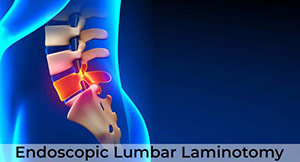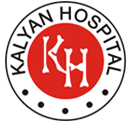Dr. Rajinder Singh - Spine Surgeon in Ludhiana
Dr. Rajinder is the best spine surgeon in Ludhiana and Managing Director of Kalyan Hospital in Ludhiana, Punjab. He has been extensively trained in simple and every type of spine surgeries. He focuses on giving the best treatment to his patients so that it helps them to live a quality life. Well, if you are struggling to get spine surgery from the best surgeon then you must visit Dr. Rajinder once. Since, he is dedicated to his profession because he knows the value of your health, money, time, and life. Moreover, he has attended many national and international conferences in his life. He has also specialization in slip disk, low back & neck pain, arthritis of the spine, and cervical treatment.

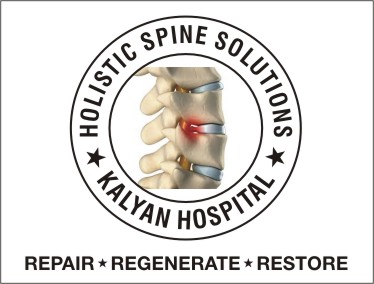
Spine Surgery in Ludhiana
EndoScopic Spine Surgery

An Endoscopic Spine Surgery in Ludhiana is a minimally invasive surgical procedure that utilizes advanced surgical instruments and magnifying systems to treat back pain and sciatica caused by disc herniations, stenosis, and spinal arthritis.
While the traditional back surgery, which is at times referred to as open spine surgery requires a surgeon to first cut the back muscle before corrections to the spine are made, the endoscopic spine surgery only requires a tiny incision to be made where an advanced surgical instrument is inserted to correct the spinal defect.
An endoscope is a tiny fiber-optic video camera utilized to view the inner parts and spine surgery endoscopes are specifically 5mm to 7mm in diameter.
A keyhole incision is made and an endoscope is introduced to remove disc material or bone spurs.
Advantages/Benefits of an Endoscopic Spine Surgery
In the current generation, an Endoscopic Spine Surgery is believed to be a minimally invasive surgery, safe and effective as compared to the open spine surgery. Various reasons may render you to opt for Endoscopic spine surgery as below;
- Minimal scarring since a tiny incision is made
- Minimal to no blood loss
- Minimal tissue damage
- Fewer chances of postoperative infection
- Less downtime
- Minimal pain
Choosing an Endoscopic spine surgeon
Matters relating to endoscopic spine surgeries are very delicate and so is one’s candidacy. The Endoscopic spine surgery cost in India shouldn’t be the fundamental influence for the surgery, but one ought to attain the basic examination and evaluation from an experienced spine surgeon.
Another consideration is the fact that not all spine surgeries are conducted endoscopically.
The Endoscopic Discectomy of the Lumbar and Cervical Spine ‘Surgery’
An ‘Endoscopic Discectomy’ is an advanced form of an endoscopic spinal surgery. Literally, it is a minimally invasive surgery where the herniated disc material is removed. When inflamed, the herniated disc material causes pain in the cervical, lumbar, and the thoracic (mid back).
This surgical approach doesn’t require a surgeon to remove bones and muscles in order to eliminate herniated discs. With that, it is an effective treatment approach for patients with spinal disc herniation.
The endoscopic approach only requires a camera to visualize the spine and tiny incisions.
A Precise Endoscopic Discectomy Procedure
STEP 1- In the operating room, intravenous sedation is administered and a small metal tube is introduced into the spine for visualization.
The herniated disc, bulging disc, and the annular tear will be observed through the tube.
STEP 2- Under the guidance of the x-ray fluoroscopy, the herniated disc will be removed using a grasper. In case required, the bulging disc and the annular tear are treated with a laser.
STEP 3- Once the procedure is done, the tube is removed and the incisions stitched.
Conditions Treated Through an Endoscopic Discectomy Surgery
- Herniated Disc
- Disc Bulge
- Disc Tear
- Radiculitis
- Radiculopathy
- Cervical Disc Tear
- Cervical Herniated Disc
- Brachial Neuritis
- Cervical Disc Bulge
Benefits of Undergoing an Endoscopic Discectomy
- Short recovery
- Minimal trauma
- Safe & Effective
- The mobility of the spine is preserved
- Minimal bleeding
Endoscopic Anterior Cervical Discectomy
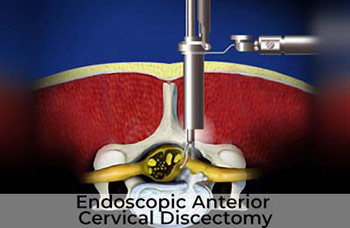
Endoscopic Lumber Discectomy
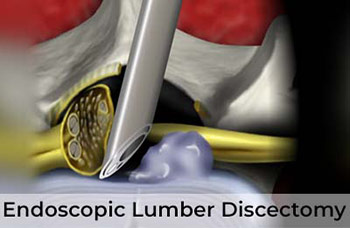
Endoscopic Posterior Cervical Discectomy
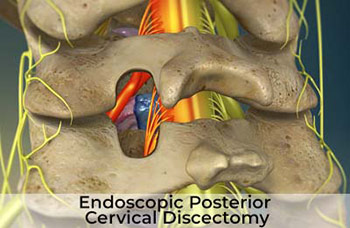
The Endoscopic Foraminotomy of the Lumbar and Cervical Spine
The Endoscopic Foraminotomy is a minimally invasive procedure conducted to relieve pressure to the spinal nerve roots. This pressure is commonly imposed by bone spurs, disc herniations, scar tissue, and ligaments.
Before an Endoscopic Foraminotomy, conservative treatment approaches are utilized. In case they fail to offer the desired goals, diagnostic procedures together with pain mapping techniques are used to understand the surgical requirements.
How the Endoscopic Foraminotomy Surgery is actually performed
STEP 1- The procedure begins with anaesthesia administration after which a metal tube is introduced into the body to observe the neuroforamen.
All surgical tools used during the procedure are passed through this tube in order to prevent muscle damage.
STEP 2- Under direct visualization, the unwanted ligament growth, bone spurs, the protruding discs, the scars, and the damaged lumbar facet are removed using specialized instruments. Surgical approaches like tools, laser, or radiofrequency are utilized to widen the nerve hole and release the compressed nerves.
STEP 3- At last, the tube is removed and the incisions stitched.
Conditions Treated Through an Endoscopic Foraminotomy Surgery
- Spinal slippage (spondylolisthesis)
- Spinal instability
- Spinal stenosis
- Foraminal narrowing (foraminal stenosis)
- Bulging disc / Disc herniation
- Failed back surgery syndrome
- Cervical spinal nerves strained by bone spurs and disc herniations
- Cervical spine degenerative disease with spinal nerve compression
Benefits of this Specialized Surgical Approach
The benefits are similar to those of any other endoscopic surgery and some include; a less downtime, minimal trauma, less bleeding, and efficacy.
Posterior Cervical Discectomy and Foraminotomy
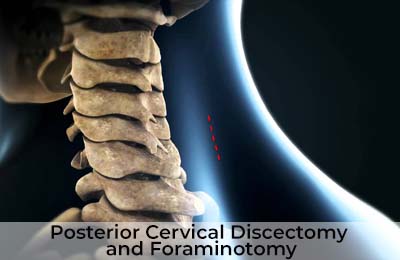
Endoscopic Lumber Foraminotomy

The Endoscopic Facet Rhizotomy
The Endoscopic Facet Rhizotomy is a surgical approach conducted to deaden the affected nerves that can trigger chronic back pain as well as neck pain. This minimally invasive surgical approach is conducted under the guidance of an endoscope. The results are minimal trauma, minor bleeding, and efficacy.
How is it conducted?
At Kalyan Hospital, an Endoscopic Facet Rhizotomy is professionally performed by an experienced orthopaedic surgeon. The entire procedure can precisely be detailed as below;
- Local anaesthesia is administered and in case required, alongside intravenous sedation.
- The intended skin regions are identified using fluoroscopic guidance, after which incisions are made.
- A small tube is then introduced through the incision and an endoscope is attached to it. With this, the surgeon is able to visualize the medial branch.
- The next step involves utilizing a laser to deaden the nerve branches (medial branch). These nerves only offer sensory function.
- At last, the tube is removed and the incisions are closed. Once a patient wakes up, he or she is advised to walk around.
Orthopaedic Cases Treated with an Endoscopic Facet Rhizotomy
They can be categorized under Lumbar Endoscopic Facet Rhizotomy and Cervical Endoscopic Facet Rhizotomy
Cervical Endoscopic Facet Rhizotomy
- Facet joint arthritis
- Chronic neck pain
- Facet hypertrophy
- Failed back surgery syndrome
- Whiplash syndromes
Lumbar Endoscopic Facet Rhizotomy
- Chronic low back pain
- Facet hypertrophy
- Failed back surgery syndrome
- Whiplash syndromes
- Facet joint injuries
- Facet joint arthritis
Why an Endoscopic Facet Rhizotomy
- Minimal bleeding
- Short downtime
- Efficacy
- Preservation of spinal mobility
Endoscopic Facet Rhizotomy

The Endoscopic Lumbar Laminotomy
Currently, patients with spinal stenosis are treated with the help of an Endoscopic Lumbar Laminotomy. The Endoscopic Lumbar Laminotomy is probably the least minimally invasive spine surgery with greater efficacy.
During the Endoscopic Lumbar Laminotomy procedure ‘laminectomy’, the surgeon will remove part of the lamina, bone spurs, the fatty ligaments, and the herniated disc materials in case required.
The Lamina & Its Removal
The lamina is a very thin layer of material and it is part of the bony arch of the vertebra. Its major job is to protect the spinal cord from damage.
As we age, the risk of spinal degeneration and spinal stenosis increase. The Spinal stenosis condition is the narrowing of the spinal canal and this can put pressure on the spinal nerves. This can trigger back pain that extends down to the lower leg and obviously a reduced quality of life.
To correct the condition and eliminate the associated symptoms, an Endoscopic Lumbar Laminotomy is performed
How is an Endoscopic Lumbar Laminotomy performed?
You will be numbed after which tiny incisions are made in the targeted region. With the help of a camera, the vertebra is visualized.
An opening of the lamina above and below the spinal disc is made to relieve nerve compression. The surgeon will also evaluate the facet joints and then perform a foraminotomy in order to decompress the spinal nerve roots.
The surgeon will also remove the herniated disc in case required and lastly stitch the incisions.
An Endoscopic Lumbar Laminotomy can also be utilized to treat
- Bone Spurs
- Spinal Stenosis
- Herniated Discs
- Facet Joint Disease
Advantages of an Endoscopic Lumbar Laminotomy surgery include;
- Minimal bleeding
- Effective
- Short recovery among others
Endoscopic Lumbar Laminotomy
